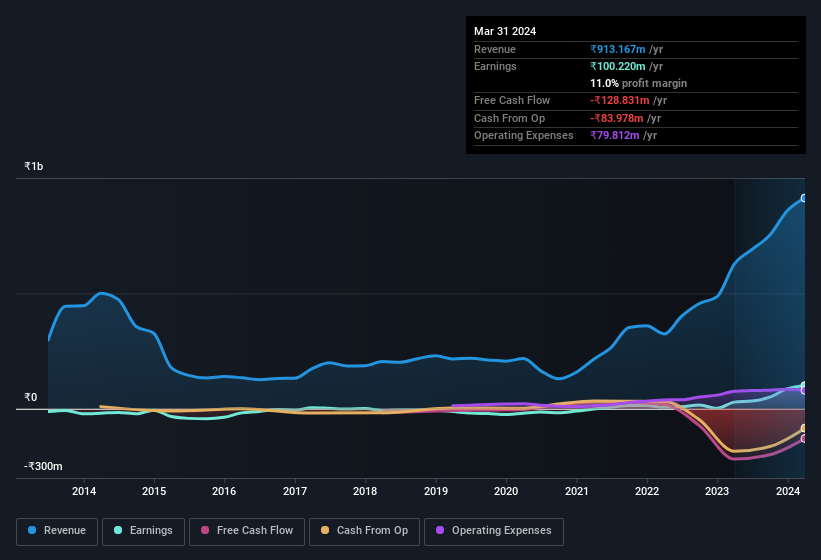- India
- /
- Specialty Stores
- /
- NSEI:THOMASCOTT
Why Thomas Scott (India)'s (NSE:THOMASCOTT) Earnings Are Weaker Than They Seem

Thomas Scott (India) Limited (NSE:THOMASCOTT) recently released a strong earnings report, and the market responded by raising the share price. While the headline numbers were strong, we found some underlying problems once we started looking at what drove earnings.
View our latest analysis for Thomas Scott (India)

Examining Cashflow Against Thomas Scott (India)'s Earnings
In high finance, the key ratio used to measure how well a company converts reported profits into free cash flow (FCF) is the accrual ratio (from cashflow). To get the accrual ratio we first subtract FCF from profit for a period, and then divide that number by the average operating assets for the period. You could think of the accrual ratio from cashflow as the 'non-FCF profit ratio'.
Therefore, it's actually considered a good thing when a company has a negative accrual ratio, but a bad thing if its accrual ratio is positive. While it's not a problem to have a positive accrual ratio, indicating a certain level of non-cash profits, a high accrual ratio is arguably a bad thing, because it indicates paper profits are not matched by cash flow. To quote a 2014 paper by Lewellen and Resutek, "firms with higher accruals tend to be less profitable in the future".
Over the twelve months to March 2024, Thomas Scott (India) recorded an accrual ratio of 0.52. Statistically speaking, that's a real negative for future earnings. And indeed, during the period the company didn't produce any free cash flow whatsoever. In the last twelve months it actually had negative free cash flow, with an outflow of ₹129m despite its profit of ₹100.2m, mentioned above. Coming off the back of negative free cash flow last year, we imagine some shareholders might wonder if its cash burn of ₹129m, this year, indicates high risk. Notably, the company has issued new shares, thus diluting existing shareholders and reducing their share of future earnings.
Note: we always recommend investors check balance sheet strength. Click here to be taken to our balance sheet analysis of Thomas Scott (India).
In order to understand the potential for per share returns, it is essential to consider how much a company is diluting shareholders. As it happens, Thomas Scott (India) issued 37% more new shares over the last year. Therefore, each share now receives a smaller portion of profit. Per share metrics like EPS help us understand how much actual shareholders are benefitting from the company's profits, while the net income level gives us a better view of the company's absolute size. You can see a chart of Thomas Scott (India)'s EPS by clicking here.
How Is Dilution Impacting Thomas Scott (India)'s Earnings Per Share (EPS)?
Three years ago, Thomas Scott (India) lost money. On the bright side, in the last twelve months it grew profit by 248%. But EPS was less impressive, up only 126% in that time. Therefore, one can observe that the dilution is having a fairly profound effect on shareholder returns.
Changes in the share price do tend to reflect changes in earnings per share, in the long run. So Thomas Scott (India) shareholders will want to see that EPS figure continue to increase. But on the other hand, we'd be far less excited to learn profit (but not EPS) was improving. For the ordinary retail shareholder, EPS is a great measure to check your hypothetical "share" of the company's profit.
Our Take On Thomas Scott (India)'s Profit Performance
In conclusion, Thomas Scott (India) has weak cashflow relative to earnings, which indicates lower quality earnings, and the dilution means its earnings per share growth is weaker than its profit growth. For the reasons mentioned above, we think that a perfunctory glance at Thomas Scott (India)'s statutory profits might make it look better than it really is on an underlying level. So while earnings quality is important, it's equally important to consider the risks facing Thomas Scott (India) at this point in time. To that end, you should learn about the 3 warning signs we've spotted with Thomas Scott (India) (including 1 which doesn't sit too well with us).
In this article we've looked at a number of factors that can impair the utility of profit numbers, and we've come away cautious. But there is always more to discover if you are capable of focussing your mind on minutiae. For example, many people consider a high return on equity as an indication of favorable business economics, while others like to 'follow the money' and search out stocks that insiders are buying. So you may wish to see this free collection of companies boasting high return on equity, or this list of stocks with high insider ownership.
Valuation is complex, but we're here to simplify it.
Discover if Thomas Scott (India) might be undervalued or overvalued with our detailed analysis, featuring fair value estimates, potential risks, dividends, insider trades, and its financial condition.
Access Free AnalysisHave feedback on this article? Concerned about the content? Get in touch with us directly. Alternatively, email editorial-team (at) simplywallst.com.
This article by Simply Wall St is general in nature. We provide commentary based on historical data and analyst forecasts only using an unbiased methodology and our articles are not intended to be financial advice. It does not constitute a recommendation to buy or sell any stock, and does not take account of your objectives, or your financial situation. We aim to bring you long-term focused analysis driven by fundamental data. Note that our analysis may not factor in the latest price-sensitive company announcements or qualitative material. Simply Wall St has no position in any stocks mentioned.
About NSEI:THOMASCOTT
Thomas Scott (India)
Manufactures and trades in textile and textile products in India.
Excellent balance sheet with proven track record.


